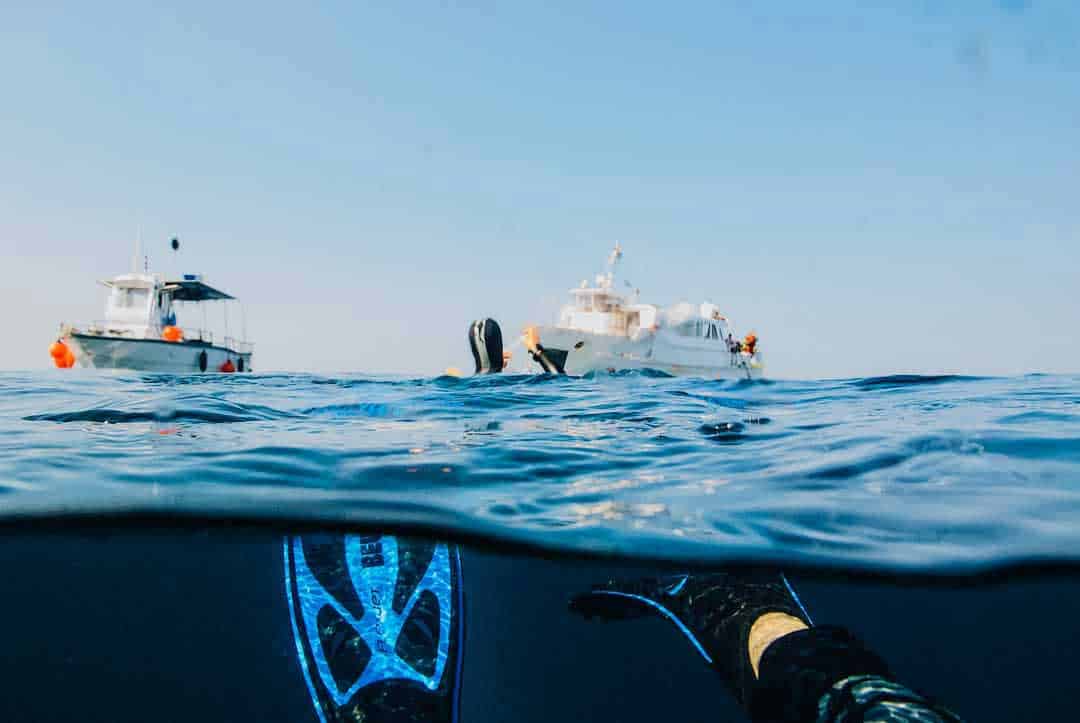When scuba diving, it is imperative that you display a dive flag to signal to others that you are underwater. Dive flags are required by law in many areas, and can be a lifesaver in an emergency.
There are different types of dive flags, and the best one for you will depend on your diving location and situation. If you are diving in an area with a lot of boat traffic, for example, you will want a flag that is highly visible and easy to spot.
In this blog post, we will review the best dive flags for snorkeling and diving in 2023. We’ll also provide a buyer’s guide to help you choose the right flag for your needs.
ALL THE DIVE FLAG FOR SNORKELING AND DIVING THAT WE TESTED
SCUBA CHOICE Diver Below Inflatable Float and Flag Buoy
General Impression
This float and flag buoy made by Scuba Choice is our top pick for the best dive flag for snorkeling. The snorkeling buoy is equipped with two break-down poles and quickly deflates for storage in a dive bag for travel from place to place. The dive flag for snorkeling is 16” x 20” and has a bright yellow base with the words “Diver Below” printed in red, making it highly visible on the surface. The 22” buoy base, towline attachment ring, and weight clip strap provide excellent stability in rough water while being towed.
Specifications
BRAND: Scuba Choice
DESCRIPTION: Inflatable Float and Flag Buoy
SUITABLE FOR: Snorkeling, Scuba Diving, and Freediving
PROS
- Easy to use flag mount and inflatable base
- 22” buoy base with weight attachment strap
- Breakdown poles for easy storage
- Diver Below printed on buoy base
CONS
- Turns over when pulling it
SCUBA CHOICE Signal Floater with Dive Flag
General Impression
This dive flag for snorkeling float, made by Scuba Choice, is our choice for the best value. The 12” x 11” detachable flag and “Diver Below” lettering can easily be seen by boaters on the surface. The flag can also be removed for storage. The dive buoy is designed with a durable loop for an attachable towline for scuba divers or snorkelers.
This inflatable signal floater is lightweight and easy to inflate or deflate. The shape of the buoy, especially when filled with water, creates little drag making it an excellent choice for beginners or experts. The material is durable and will stand up to continued use, making it an excellent choice for the price.
Specifications
BRAND: Scuba Choice
DESCRIPTION: Inflatable Signal Floater with Dive Flag
SUITABLE FOR: Snorkeling and Scuba Diving
PROS
- 12” x 11” attachable flag
- Durable loop for towline
- Easy to inflate and deflate
CONS
- Not the best design
JCS Foam Dive Float with Dive Flag
General Impression
This foam dive flag for snorkeling float made by JCS is durable and lightweight. The 4-foot float pole and 14” x 18” attachable dive flag make this dive buoy highly visible from long distances for increased safety. The pole is foldable for ease of storage and transport. The foam attachment is highly buoyant, and the bottom is weighted with lead to keep the dive flag from becoming inverted while being towed. The attachable nylon dive flag for snorkeling also comes with a steel wire stiffener to keep the dive flag for snorkeling in place.
Specifications
BRAND: JCS
DESCRIPTION: Foam Dive Float with Flag
SUITABLE FOR: Scuba Diving, Freediving, and Snorkeling
PROS
- Foldable Float Pole
- 14” x 18” Dive Flag
- Eyelet for line attachment
- Lead weighted bottom
CONS
- Important to rinse with fresh water and store indoors with not using
SCUBA CHOICE Palantic Torpedo Float with Dive Flag
General Impression
The Palantic nylon torpedo float with dive flag, made by Scuba Choice, is constructed from 420D nylon material on the outside, which is more durable than traditional PVC, making it a durable option when choosing a dive float. The inner PVC bladder is easy to inflate and can be deflated easily as well for storage. This dive float also comes with a 7.5” x 7.5” attachable nylon dive flag and a 60’ orange tow string. Divers have had the most success with this product when attaching a reel and weights for ballast, using the black clips, so the dive flag for snorkeling does not tip over while diving.
Specifications
BRAND: Scuba Choice
DESCRIPTION: Nylon Torpedo Float with flag
SUITABLE FOR: Scuba Diving, Snorkeling, and Spearfishing
PROS
- 420D Nylon Material
- PVC Inner Inflatable Bladder
- Nylon Dive Flag
- Luminescent Orange Tow String
CONS
- Needed to add some weight to keep from flipping
SALVIMAR Covered Torpedo Buoy
General Impression
The SalviMar covered torpedo buoy is a good choice for snorkeling, scuba diving or Spearfishing. The dive buoy comes with two dive flags for snorkeling, the standard red and white divers flag, and the alpha flag. However, the dive flag for snorkeling size is not regulation size for Florida state laws, so keep this in mind when purchasing. The fabric cover is durable and will last through many dives. The sewn-on rings can be used to attach a reel, weights for ballast, or a small mesh bag. The torpedo design creates little drag while towing.
Specifications
BRAND: SalviMar
DESCRIPTION: Covered Torpedo Buoy
SUITABLE FOR: Scuba Diving, Snorkeling, and Spearfishing
PROS
- Fabric Cover
- Clippable Rings
- Two dive flags included
CONS
- The flag size is tiny
JCS Scuba Dive Float Assembly
General Impression
The JCS Complete Cordura Nylon Scuba Dive Float Assembly is at a higher price point but has a lot to offer scuba divers, snorkelers, and spearfishers. The Cordura nylon float cover offers exceptionally high durability. The float cover is constructed with a fully zippered storage compartment for the dive flag for snorkeling, pole, and other diving necessities. It is equipped with four sewn-in handles and a D-ring on the bottom to attach a reel, weights, or other items while diving. The removable dive flag is 14” x 18” and comes with a collapsible pole for high visibility and easy storage.
Specifications
BRAND: JCS
DESCRIPTION: Nylon Scuba Dive Float
SUITABLE FOR: Snorkeling, Scuba Diving, and Spearfishing
PROS
- Cordura Nylon Float Cover
- 14” x 18” Dive Flag with Pole
- Full Zippered Storage Compartment
- 4 Sewn-in Handles
CONS
- Once anchor and weights are attached, a lot of stress to the mesh side
BEST DIVE FLAG FOR SNORKELING AND DIVING
Buyer's Guide
Why do you need a Dive Flag
Anytime you are planning a trip into the water; it is best practice to carry a dive flag for snorkeling with you. Regardless of the body of water you will be diving in, a dive flag for snorkeling will increase safety, especially when powered watercraft will also be in the area. Depending on the area you will be snorkeling in, you may or may not need to carry a dive flag for snorkeling. If you are snorkeling in a protected marine park area or a designated area for swimming, it is not required.
Many states and countries have laws regarding diving with a recognized dive flag for snorkeling. Reviewing these laws and guidelines is very important before entering the water for a dive. Diving without a diver down dive flag for snorkeling or buoy not only jeopardizes your safety, but you could also be fined or charged for not adhering to the standards.
If you are diving from a boat, the boat should display the red and white diver down flag while divers are in the water. The dive flag for snorkeling shows other boats to use caution in the area and keep an eye out for divers surfacing. Once divers are no longer in the water or the vessel is underway, the dive flag for snorkeling must be taken down.
If you are diving from shore without a boat, you are at an even higher risk of not being seen by passing boats. If you are approaching the surface or on the surface without a dive symbol, boaters may not see you, putting you at risk of a run-in with a boat hull or propeller. A dive flag float can also be helpful if you surface from a dive far from your group or the dive boat. You will be found much more quickly if you have a bright, recognized marker with you at the surface.
Displaying a dive flag for snorkeling while in the water will increase your visibility and your safety in most cases. But anytime you are in the water; it is essential to be aware of your surroundings. New boaters may not know the laws or guidelines well, or boat set on autopilot may be passing and not realize you are in the water. There is always a risk of a negligent boater being in the area as well. Staying aware and following the guidelines will decrease your chances of being in an accident.
Types of Dive Flags
A diver down flag, also commonly known as a scuba flag is used by divers, snorkelers, and spearfishers to indicate there is a diver in the water. The diver may be on the surface or below the surface. There are two types of diver down flags. The alpha flag, which is also known as the International Maritime Signal Flag, is white and blue.
The other type of diver-down flag is red with a white diagonal stripe. Both types of flags are used to signal that there are divers in the water, and all vessels should keep clear and use a slow speed.
The alpha flag is more commonly used in Europe and the red and white diver down flag is used in the United States, Canada, and some Caribbean countries. Some vessels use both flags to make sure at least one of them is recognized by boaters.
Alec Pierce Scuba has created a YouTube video that discusses four types of dive flags and floats. The information in this video is helpful as it presents the types of dive floats from a very basic model to more complex instructor models with extra features like storage.
How to use a Dive Flag
The distance boaters should stay from a diver-down flag may vary from place to place. Always consult local laws before snorkeling or diving. PADI has a rule of thumb for you to stay within 15 meters/50 feet of your dive flag and for boats to remain at least 30 to 60 meters/100 to 200 feet away from you.
Two examples of laws regarding diver down flags are as follows:
In Michigan, the law requires divers to stay within 100 feet vertically from their dive buoy and boaters to stay at least 200 feet away from a diver-down flag. In Florida, divers are required to display a diver-down flag and remain within 100 feet of it while diving in rivers, inlets and navigation channels. In other waters, the distance is 300 feet, and boats are required to maintain the same distances from dive flags.
When using a divers flag or snorkeling buoy, make sure the flag is visible at all times on the surface. Depending on the type of buoy you choose, you may need to add weights or water inside the buoy for ballast and to make sure the flag stays upright. Many dive floats come with a clippable tow line, but it is also recommended to purchase a durable, tangle-proof line and reel along with your dive buoy.
Along with a diver down flag, you may want to also invest in a good quality dry snorkel and snorkel vest if you are new to snorkeling or freediving. And remember, always rinse your diving gear with fresh water after each use. Rinsing your gear will prolong the life of your equipment and prevent it from deteriorating.
BEST DIVE FLAG FOR SNORKELING AND DIVING
FAQs
1. How close should you stay to your dive flag?
Local laws for carrying a dive flag for snorkeling, scuba diving, or Spearfishing may vary. These laws will regulate how close you have to stay to your flag and how far boaters must stay away from you. Some areas of the world do not have specific laws or regulations regarding dive flags. In these areas, you should refer to local dive training agencies for recommended distances. For example, PADI has a rule of thumb for you to stay within 15 meters/50 feet of your dive flag and for boats to remain at least 30 to 60 meters/100 to 200 feet away from you.
2. Do you need a dive flag for snorkeling?
Depending on the area you will be snorkeling in, you may or may not need to carry a dive flag for snorkeling. If you are snorkeling in a protected marine park area or a designated area for swimming, it is not required. However, in certain areas, it may be necessary that divers and snorkelers carry a visible dive flag while in the water for safety purposes. Always check local laws before entering the water to snorkel with or without a dive flag.
3. What does a diver-down flag look like?
A diver down flag, also commonly known as a scuba flag is used by divers, snorkelers, and spearfishers to indicate there is a diver in the water. The diver may be on the surface or below the surface. There are two types of flags in use. The alpha flag, which is also known as the International Maritime Signal Flag, is white and blue. The other type of diver-down flag is red with a white diagonal stripe. Both types of flags are used to signal that there are divers in the water, and all vessels should keep clear and use a slow speed.
4. Where does the dive flag come from?
Denzel James Dockery originally invented the red and white dive flag in Michigan in the 1950s. Dockery used the Navy’s red “Bravo flag” that meant danger and sewed a horizontal white stripe across the flag. After a while, he realized this was the same design of the national flag of Austria, so he changed the design using a diagonal white stripe from the top left to the bottom right instead. States slowly adopted this flag and passed laws making it mandatory to fly the flag on dive boats. The red and white flag is now also known as the international symbol for scuba diving.
5. How to tow a dive flag?
There are a few different ways to tow a dive flag. Some divers prefer to use a spool or reel that they can hold in their hand during a dive. When moving up and down to different depths, the diver can reel the line in and out as needed. Some divers tend to clip or secure the line to them if they are at the same depth for an extended time. But this could be dangerous if the line becomes entangled or pulled accidentally by a boat. For snorkeling, the flag line can be held in your hand or secured to your person. For Spearfishing, to keep your hands free, you may set up a system that allows the line to be reeled in or out when diving down to catch fish but allowing the dive flag to remain at the surface.
6. What size dive flag in should I use in Florida?
In 2014, Florida passed a new law regarding dive flags. The new law, “Requires all divers to prominently display divers-down flags or buoys in areas in which diving occurs; requires vessel operators encountering divers-down buoys to take specified actions; prohibits divers-down buoys from being used or displayed onboard vessels.” Currently, Florida law requires divers to display the red and white diver down flag that is square or rectangular and is at least 12”x12” or 24”x24” if displayed on a dive vessel. The width of the stripe must be 25% of the height of the flag.
7. If you see a displayed diver-down flag while boating, how far away from the flag must you stay?
The distance boaters should stay from a diver-down flag may vary from state to state and from country to country. Also, consult local laws before snorkeling or diving. PADI has a rule of thumb for you to stay within 15 meters/50 feet of your dive flag and for boats to remain at least 30 to 60 meters/100 to 200 feet away from you. In Michigan, the law requires divers to stay within 100 feet vertically from their dive buoy and boaters to stay at least 200 feet away from a diver-down flag. In Florida, divers are required to display a diver-down flag and remain within 100 feet of it while diving in rivers, inlets and navigation channels. In other waters, the distance is 300 feet, and boats are required to maintain the same distances from dive flags.
8. How to display a dive flag correctly?
Individual state and international laws may vary with regard to displaying a dive flag correctly and the distance to stay from them. In most waters, it is required to display a dive flag on a vessel anytime divers are in the water, and to remove the flag from its position on the boat when divers are not in the water or the vessel is underway. Some places also require snorkelers and divers to carry a diver-down with them while in the water, so they are more visible to passing boat traffic. The size and type will vary from location to location.
9. What does a red flag with a diagonal white stripe mean?
A red flag with a diagonal white stripe is known as the international symbol for scuba diving. These flags are used as a sign that divers are in the water in that area. Most commonly called the diver-down flag, the red and white flag will either be displayed on a dive boat or carried in the water while snorkeling, scuba diving, freediving, or Spearfishing. The red and white flag is usually a square or rectangular shaped flag with a pole that can be attached to a boat or float buoy.
10. The blue and white alpha flag signifies what?
The blue and white alpha dive flag for snorkeling is an international maritime symbol flag. It is also known as the A-flag, and it indicates the presence of a diver in the water. The flag also warns other vessels of the danger of collision. When a vessel has this flag displayed, it also means their maneuvering may be limited due to having divers in the water. The blue and white alpha dive flag for snorkeling is more commonly used in Europe and the British Commonwealth. The alpha flag is not used in the United States, Canada, (sometimes) Italy, or in Caribbean countries following American diving practices.
REACH OUT
As always, we create our content with you, fellow adventurers, in mind. So, how’d we do? Did you find this informative? Did it help you make a decision? Did we miss anything? We’d love to hear from you below. Thanks for reading and we hope your next adventure is a great one!























